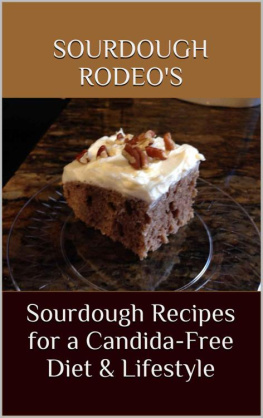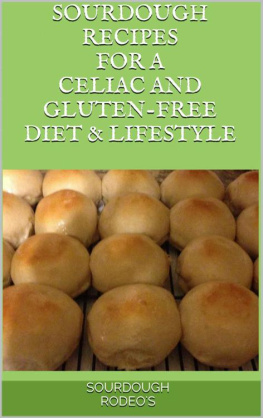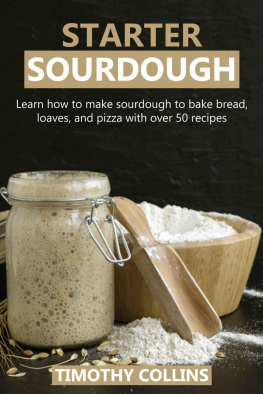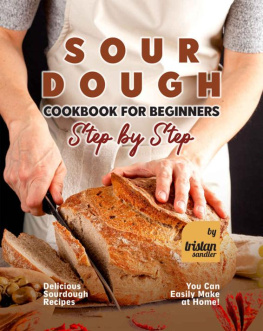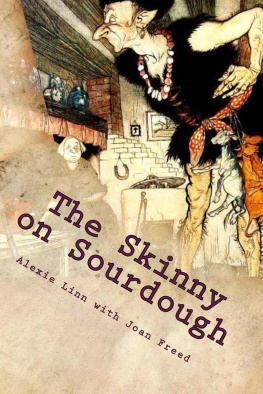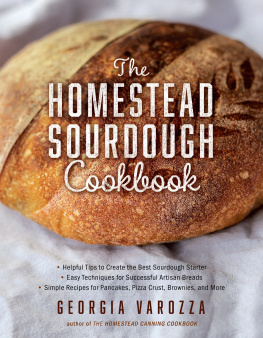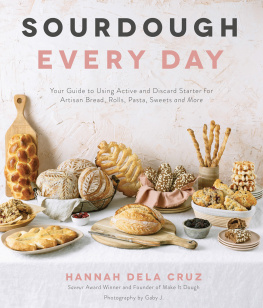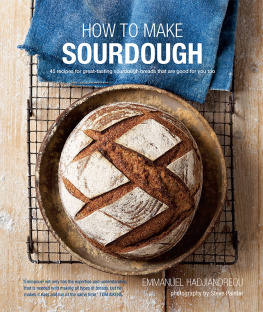Sourdough
Rodeos
Sourdough
Recipes
for a
Candida-Free Diet
& Lifestyle
Table of Contents
Sweets and Baked Goods
Part
One
Getting
Started
Welcome
We started collecting these recipes for our own use when we discovered that we were each having difficulties with a systemic overgrowth of Candida Albicans. Add in one of us with Irritable Bowel Syndrome (IBS) and a Gluten Intolerance and the other one with Acid Reflux, and we were desperately searching for food that was not only healthy for us, but that would also taste good and be satisfying.
After a lot of trial and error, oodles of sharing baked goods with our family and neighbors and massive amounts of typing, retyping and re-retyping recipes, we ended up with these favorites.
We believe that weve found the answer to our search here, with these recipes, and hope that you will too.
If you have questions, comments, or suggestions, wed love to hear from you.
Check out our website: www.SourdoughRodeo.com
Or email us at:
Happy Baking!
Kathy & Lori
Why Sourdough?
Why Sourdough can be Good for people following Candida and Celiac Diets
Sourdough bread is made by a long fermentation process of dough that uses naturally occurring or "wild" yeasts and Lactobacilli .
In addition to making great tasting bread and baked goods, Sourdough improves bread quality by causing bread to stay fresher longer while also improving its nutritional properties. The Lactic Acid produced by the Lactobacilli is what causes that sour taste that is so well-loved.
Recent studies have shown that sourdough fermentation can also encourage digestive healing in people with Celiac disease when eaten as part of a Gluten-Free diet. For several years researchers have been experimenting with sourdough as a way to make bread made with wheat safe for people with Celiac disease.
To make Sourdough goods baked with wheat flour safe for Celiac's, Candida Sufferers and anyone following a Gluten-Free diet, all of the flour used in a recipe must ferment with the Sourdough Starter for at least 7 hours. It is this process that "kills" or renders the gluten harmless. Most store-bought "Sourdough" breads are not baked using this method nor a traditional starter and thus, despite being "Sourdough", are not safely gluten-free. For more information and links to research regarding this process, check out our website: www.SourdoughRodeo.com
As always, you should check with your doctor or nutritionist regarding changes in your diet, as not everyone has the same degree of difficulty with gluten and each person can react differently to including it in their diet.
What is Sourdough Starter?
Sourdough Starter is a culture that grown from a combination of Wheat or Rye Flour and water that mixes with the naturally occurring Lactobacilli , or wild-yeast, that can be found in the air around us. It has a somewhat sour odor, is usually creamy white or light tan in color and has the consistency of an extremely thick cake batter. Sourdough Starter is generally used to replace yeast in baked goods.
The use of Sourdough Starter is rich in history and dates bake to at least 3700 BC. Miners during the gold rush in Alaska often used Sourdough Starter as a base for their breads because the extreme temperatures made using conventional leavenings such as yeast and baking soda much less reliable.
How to Begin
Creating Your Own Starter
You can choose to begin your starter from either a Wheat-Flour or a Rye-Flour base. Wheat-Flour makes obvious sense, so why would you use Rye-Flour? It all boils down to which flour has the most consistent results and Rye-Flour has them. Dont worry if you dont want to always be eating bread and baked goods made with Rye. You only begin the process with the Rye Flour. Youll switch to Wheat Flour once your Sourdough Starter is active (begins bubbling). By the time you begin baking with your starter, it will be mostly wheat and it is unlikely that youll be able to taste it in the finished product. Eventually, the amount of Rye in the starter will become negligible.
What youll Need:
Pint-sized or Quart Sized Glass/Plastic Jar or Container
Plastic Wrap
Cheese Cloth
Rubber band (or other Fastener to secure Cheese Cloth to Container)
Wood/Rubber/Plastic Spoon or Spatula
Wheat Starter
Ingredients
High Quality Bread Flour (Such as King Arthur Bread Flour)
Spring Water (Warm, Not Hot)
Directions
Day 1 - Combine 1 Tablespoon Bread Flour and 2 Tablespoons Spring Water in a pint or quart glass jar using a wood/plastic spoon or spatula. Cover loosely with plastic wrap and put in a warm place. Stir two or three times throughout the day. This is the basis for your Sourdough Starter.
Day 2 - Stir two or three times throughout the day.
Day 3 - Add 2 Tablespoons Bread Flour and 2 Tablespoons Spring Water to the Sourdough Starter . Replace plastic wrap with muslin or cheesecloth and secure with a rubber band. Continue to stir two or three times throughout the day.
Day 4 - Add 2 Tablespoons Bread Flour and 1 Tablespoon Spring Water to the Sourdough Starter . Continue to stir two or three times throughout the day.
Days 5-6 - Add 2 Tablespoons Bread Flour and 2 Tablespoons Spring Water to the Sourdough Starter. Continue to stir two or three times throughout the day. (If you started in a small jar, youll probably need to move to a quart (or larger) jar at this point.)
Days Seven Nine Add 1/4 Cup Bread Flour and 2 Tablespoons Spring Water to the Sourdough Starter . Stir only when feeding. (If your Starter is not bubbling at this point, you might need to feed it twice a day until it gets going. A Hungry Starter will not bubble or expand.)
Day 10 & beyond Add 1/2 Cup Bread Flour and 1/4 Cup Spring Water to the Starter . Stir only when feeding. Continue this step until you have at least 3 cups of Starter . (Most recipes call for at least 1 cup of Starter so if you start baking with it too soon, youll run out of starter.) Once you reach this point, remove the amount of Starter needed for your recipe and feed as usual. Youll find more information on maintaining your starter once youve reached this point, in the section titled .
Rye Starter
Ingredients
Rye Flour
High Quality Bread Flour (Such as King Arthur Bread Flour)
Spring Water (Warm, Not Hot)
Directions
Day 1 - Combine 1 Tablespoon Rye Flour and 2 Tablespoons Spring Water in a pint or quart glass jar using a wood/plastic spoon or spatula. Cover loosely with plastic wrap and put in a warm place. Stir two or three times throughout the day. This is the basis for your Sourdough Starter.
Day 2 - Stir two or three times throughout the day.
Day 3 - Add 2 Tablespoons Rye Flour and 2 Tablespoons Spring Water to the Sourdough Starter . Replace plastic wrap with muslin or cheesecloth and secure with a rubberband. Continue to stir two or three times throughout the day.
Day 4 - Add 2 Tablespoons Rye Flour and 1 Tablespoon Spring Water to the Sourdough Starter . Continue to stir two or three times throughout the day.
Days 5-6 - Add 2 Tablespoons Rye Flour and 2 Tablespoons Spring Water to the Sourdough Starter. Continue to stir two or three times throughout the day. (If you started in a small jar, youll probably need to move to a quart (or larger) jar at this point.)
Next page
